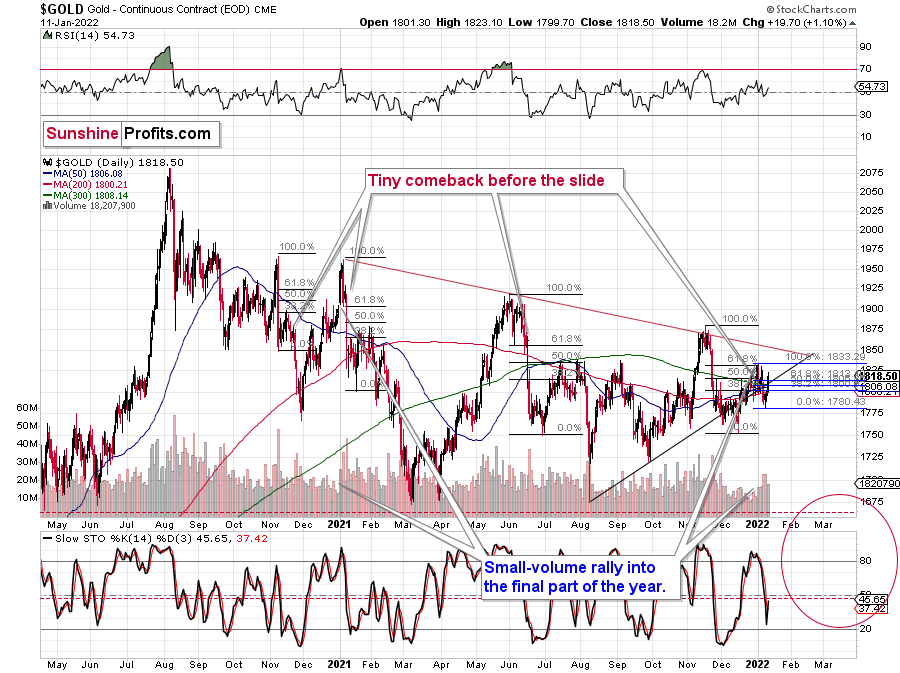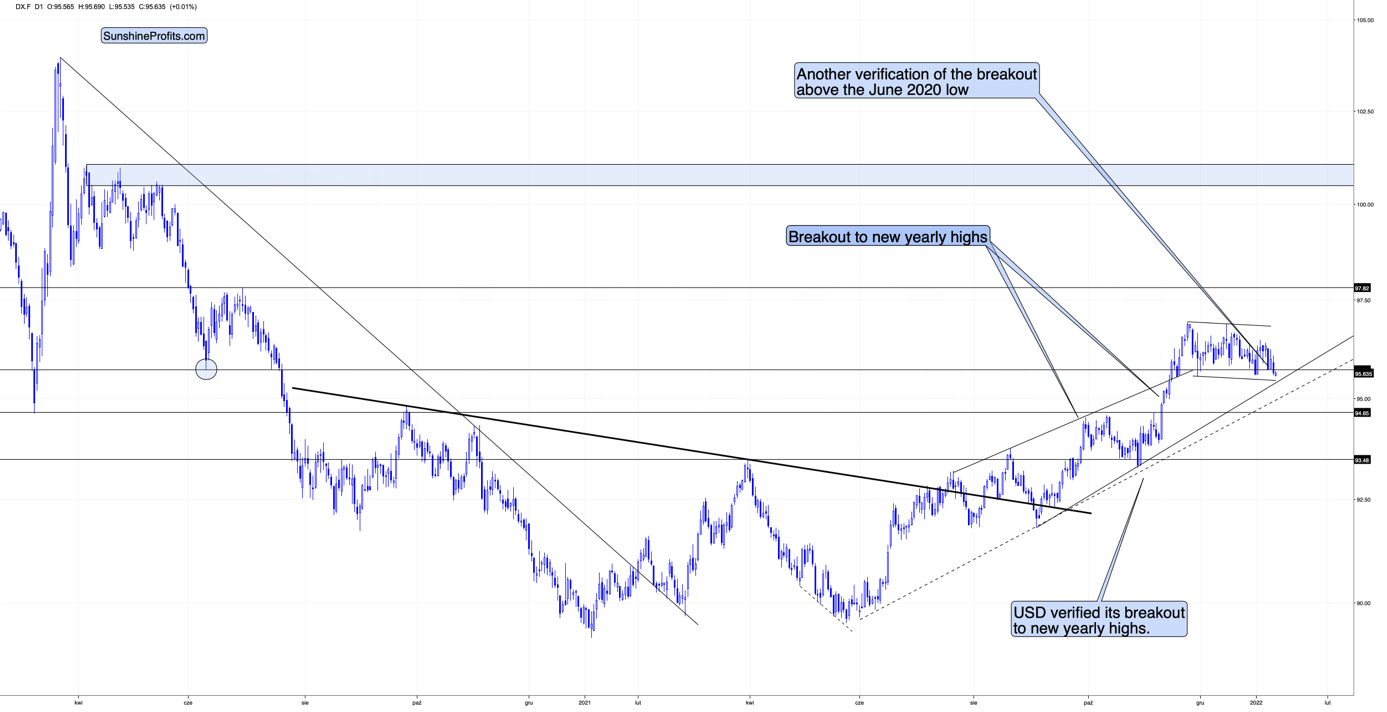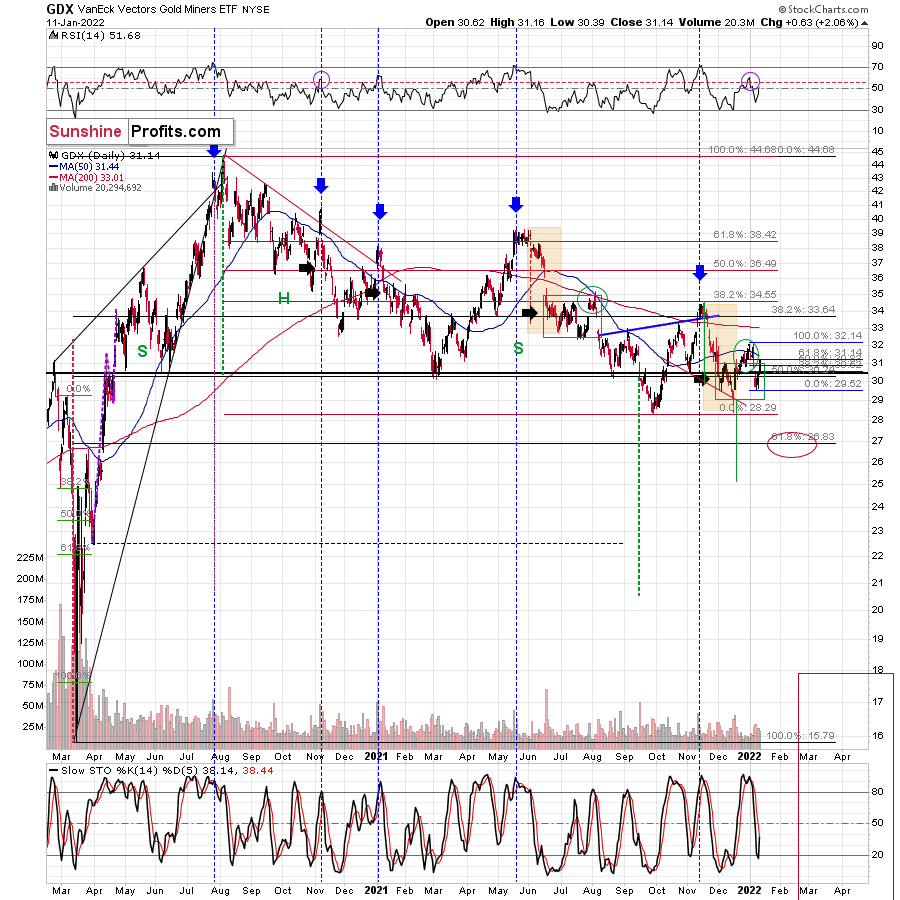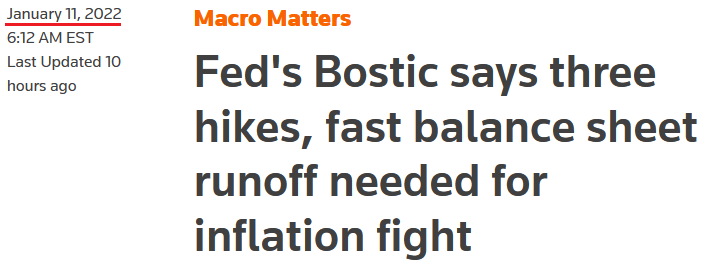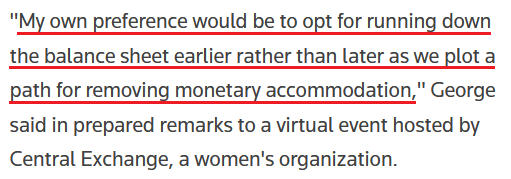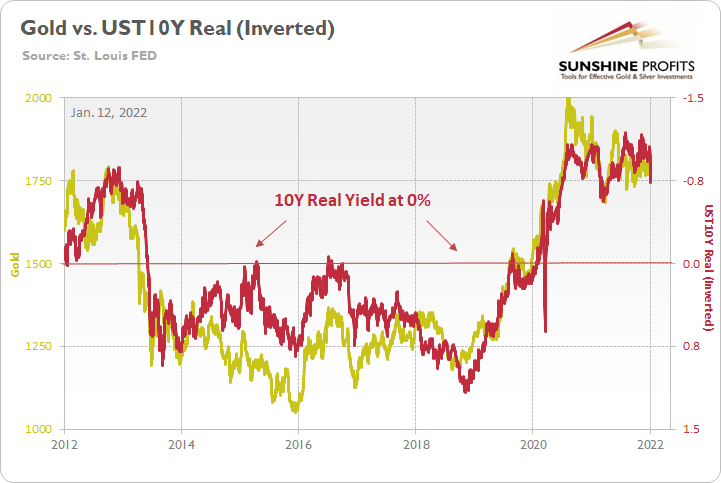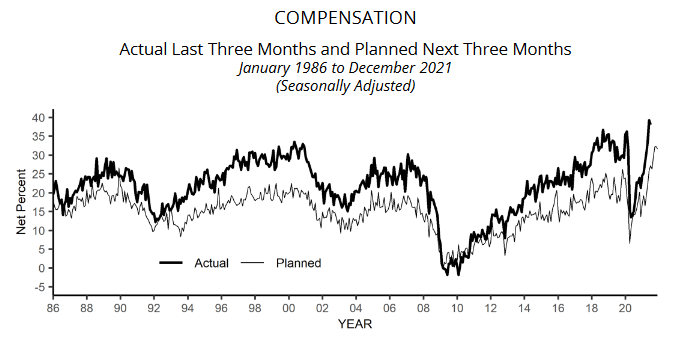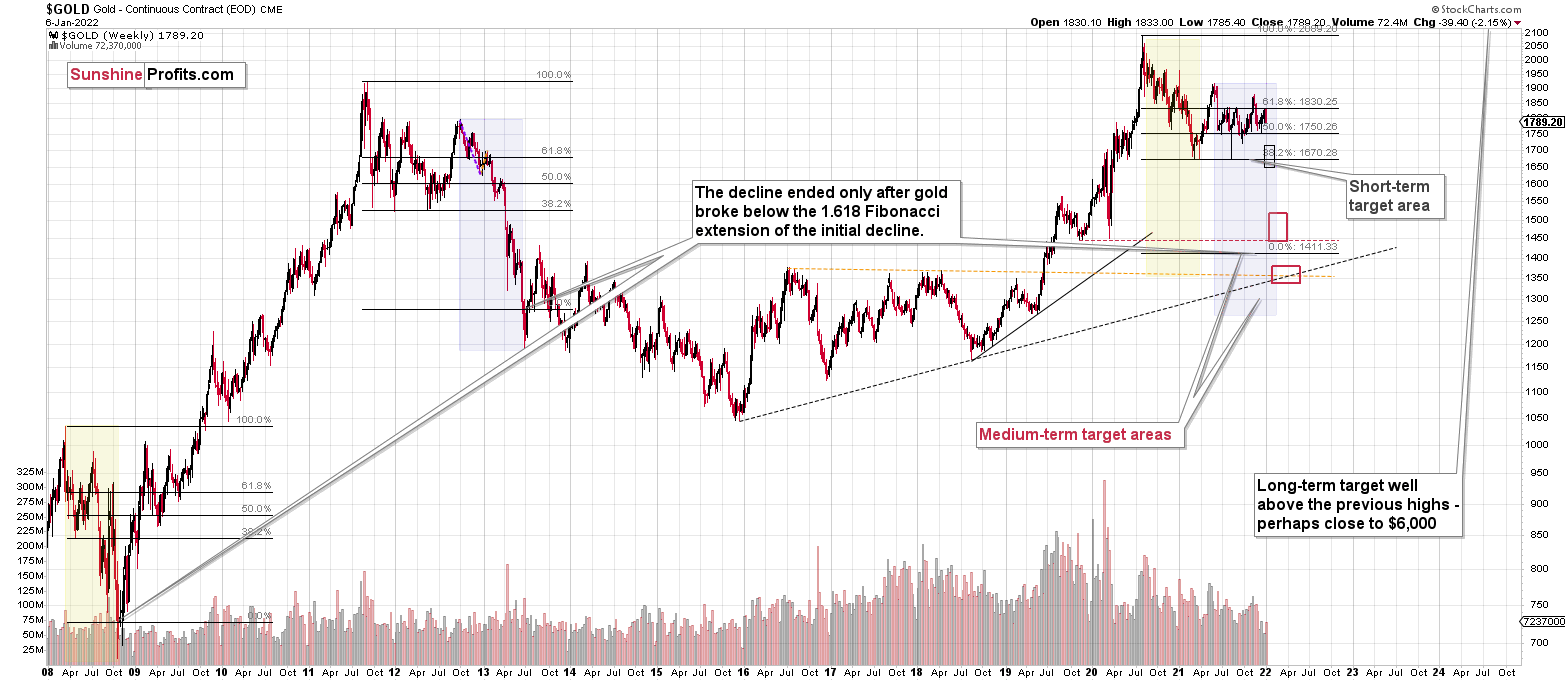Briefly: in our opinion, full (300% of the regular position size) speculative short positions in junior mining stocks are justified from the risk/reward point of view at the moment of publishing this Alert.
No market moves in a straight line, up or down, even during big, medium-term moves. While gold’s yesterday’s run-up might seem bullish, it’s a rather normal part of a bigger decline. 2022 is still a down year for gold.
As you can see on the above gold chart, the yellow metal rallied more than 61.8% of its preceding decline. This appears encouraging, as anything below that would be a correction in technical terms. However, just because gold rallied more doesn’t mean that the outlook is automatically bullish. Other factors need to be considered as well.
For example, let’s check what happened in the USD Index.
Well, the USD Index is once again slightly below its June 2020 low. That’s the third time we’ve seen this tiny breakdown since the U.S. currency moved higher. In both previous cases, the USDX then moved back up and rallied quite visibly. Is this time any different? History tends to rhyme, meaning things are usually “not different”, which has bullish implications in the current situation.
There’s one thing that’s actually different this time, and that’s the fact that right now, the USD Index is close to its rising support line based on the September and October 2021 lows. This line crosses the short-term support line at about 95.4. That’s just 0.13 below today’s intraday low. In other words, it seems that this double support level might be hit at any hour now.
While this move lower might trigger immediate-term strength in the PMs and miners, it’s also what might trigger a much bigger rally in the USD Index and much bigger declines in the PMs and miners in the following days and perhaps weeks.
Consequently, based on the both above charts, the outlook for the precious metals sector didn’t improve and it remains bearish.
Also, please note that while gold rallied more than 61.8% of the previous decline, mining stocks didn’t break above the analogous threshold. Consequently, we once again have a situation where mining stocks underperform gold. This serves as bearish confirmation for the PMs and miners.
Having said that, let’s take a look at the markets from a more fundamental point of view.
Know When to Hold ‘Em, Know When to Fold ‘Em
While gamblers returned to the stock market and their optimism helped uplift the PMs, Fed hawks were out in full force on Jan. 11. While market participants ignored their ominous warnings, the harsh realities will likely sink in over the medium term.
To explain, I wrote on Jan. 5:
Investors have gotten so used to a dovish Fed that they assume Chairman Jerome Powell won’t follow through and raise interest rates. However, with rampant inflation, a hot labor market and a resilient U.S. economy still in play, the PMs may find out the hard way that the Fed isn’t bluffing.
To that point, Powell was questioned about monetary policy by the Senate Banking Committee on Jan. 11. He said:
“To get the kind of very strong labor market we want, with high participation, it is going to take a long expansion. To get a long expansion we are going to need price stability. And so in a way, high inflation is a severe threat to the achievement of maximum employment.”
Moreover, while I’m skeptical that Powell will be able to pull this rabbit out of his hat, he made it clear that quantitative tightening (selling assets and reducing the balance sheet) remains likely in 2022.
“The balance sheet is much bigger and so the runoff can be faster. So I would say sooner and faster – that much is clear,” said Powell.
Thus, while another (likely) short squeeze helped uplift the S&P 500 and the PMs, and hurt the USD Index, the reality is that Powell was more hawkish on Jan. 11 than at any point in 2021.
On top of that, Cleveland Fed President Loretta Mester told Bloomberg on Jan. 11 that she supports a rate hike in March and has penciled in three rate hikes in 2022.
"If the economy in March looks like it does today and the outlook is similar (...), then I would support moving the funds rate up at that meeting and starting to move back from some of the extraordinary accommodation we needed earlier in the pandemic.”
Likewise, she also said that quantitative tightening should be a priority in 2022.
"I'd like to set a path for the balance sheet," Mester said. "That will reduce accommodation and then we'll use our policy tool, the Fed funds rate, as our active tool."
What’s more, Atlanta Fed President Raphael Bostic said on Jan. 11 that he expects three rate hikes in 2022 and a drawdown of the Fed’s balance sheet.
Please see below:
Making four of a kind, Kansas City Fed President Esther George said on Jan. 11 that with inflation mirroring the 1980s and the U.S. labor market in solid shape, the Fed's "very accommodative" policies are no longer needed:
As a result, while the price action on Jan. 11 suggests otherwise, the foursome's remarks are extremely bullish for the USD Index and U.S. Treasury yields and bearish for the PMs. While I warned throughout 2021 that surging inflation would elicit a hawkish shift, Fed officials are making their points loud and clear. Thus, while 'risk-on' sentiment returned to the financial markets on Jan. 11, optimism should evaporate as the tightening process unfolds.
To that point, billionaire hedge fund manager Paul Tudor Jones warned on Jan. 11 that he doesn’t “think [Powell] can catch up fast enough to try to deal with the inflation problem he has right now.” He added: “We're getting ready to see a major shift, and it's going to have a lot of consequences for a variety of asset prices."
Moreover, he sees "tough sledding" ahead for stocks as the Fed may end up popping the "financial bubble" and the realization could result in "huge negative economic consequences".
As a result, "the things that performed the best since March of 2020 are going to probably perform the worst in this tightening cycle," said Jones.
To explain, while he hinted at hyper-growth NASDAQ stocks and speculative assets like cryptocurrencies, the PMs suffer from a similar fundamental affliction. For context, the PMs are less volatile than speculative assets. However, it's important to remember that gold, silver, and mining stocks peaked amid the liquidity-fueled surge in the summer of 2020. Likewise, their uprisings coincided with real interest rates that were at all-time lows at the time.
Conversely, with the Fed's liquidity drain already unfolding and real interest rates poised to rise in the coming months, the PMs should suffer from the likely re-pricings. For example, when the U.S 10-Year real yield was at 0% or higher from June 2013 until October 2018, gold was stuck below $1,400 during that timeframe and actually fell below $1,100. As a result, if the Fed pushes its hawkish chips into the middle, don't be surprised if the PMs fold in 2022.
Finally, with the U.S. Bureau of Labor Statistics (BLS) releasing December’s Consumer Price Index (CPI) today, another hot inflation print should materialize. With pricing pressures unlikely to abate without policy action, the release should support the Fed’s newfound hawkish disposition.
To that point, the NFIB released its Small Business Optimism Index on Jan. 11. While the headline index increased from 98.4 in November to 98.9 in December, NFIB Chief Economist Bill Dunkelberg said:
“Small businesses unfortunately saw a disappointing December jobs report, with staffing issues continuing to impact their ability to be fully productive. Inflation is at the highest level since the 1980s and is having an overwhelming impact on owners’ ability to manage their businesses.”
On top of that, the report revealed:
“Twenty-two percent [of small business owners] report inflation as the single most important problem operating their business, a 20-point increase from the beginning of 2021 and the highest level since Q4 1981.”
As for wage inflation:
“A net 48 percent reported raising compensation, up 4 points from November and a 48-year record high reading. A net 32 percent plan to raise compensation in the next three months, unchanged from November’s record high reading.”
Please see below:
The bottom line? While the price action on Jan. 11 was contradictory, the fundamentals underpinning the USD Index and U.S. Treasury yields continue to strengthen. As such, the fundamentals underpinning the PMs continue to weaken. While the PMs attempt to call the Fed’s bluff, they’ll likely find out the hard way that the central bank has a really strong hand. With inflation, employment, and consumer demand akin to three of a kind, the cards will likely be unkind to the PMs over the medium term.
In conclusion, the PMs rallied on Jan. 11, as the bulls gored everything in sight. However, with the fundamental outlook contrasting the recent price action, the PMs’ ‘lower highs, lower lows’ story of 2021 should continue in 2022. Moreover, while the U.S. 10-Year Treasury yield consolidates after surpassing its 2021 high, more upside should materialize over the next few months. As a result, the precious metals’ bearish outlooks remain unchanged.
Overview of the Upcoming Part of the Decline
- It seems to me that the corrective upswing is over, and that gold, silver, and mining stocks are now likely to continue their medium-term decline.
- It seems that the first (bigger) stop for gold will be close to its previous 2021 lows, slightly below $1,700. Then it will likely correct a bit, but it’s unclear if I want to exit or reverse the current short position based on that – it depends on the number and the nature of the bullish indications that we get at that time.
- After the above-mentioned correction, we’re likely to see a powerful slide, perhaps close to the 2020 low ($1,450 - $1,500).
- If we see a situation where miners slide in a meaningful and volatile way while silver doesn’t (it just declines moderately), I plan to – once again – switch from short positions in miners to short positions in silver. At this time, it’s too early to say at what price levels this could take place, and if we get this kind of opportunity at all – perhaps with gold close to $1,600.
- I plan to exit all remaining short positions once gold shows substantial strength relative to the USD Index while the latter is still rallying. This may be the case with gold close to $1,350 - $1,400. I expect silver to fall the hardest in the final part of the move. This moment (when gold performs very strongly against the rallying USD and miners are strong relative to gold after its substantial decline) is likely to be the best entry point for long-term investments, in my view. This can also happen with gold close to $1,375, but at the moment it’s too early to say with certainty.
- As a confirmation for the above, I will use the (upcoming or perhaps we have already seen it?) top in the general stock market as the starting point for the three-month countdown. The reason is that after the 1929 top, gold miners declined for about three months after the general stock market started to slide. We also saw some confirmations of this theory based on the analogy to 2008. All in all, the precious metals sector is likely to bottom about three months after the general stock market tops.
- The above is based on the information available today, and it might change in the following days/weeks.
You will find my general overview of the outlook for gold on the chart below:
Please note that the above timing details are relatively broad and “for general overview only” – so that you know more or less what I think and how volatile I think the moves are likely to be – on an approximate basis. These time targets are not binding or clear enough for me to think that they should be used for purchasing options, warrants or similar instruments.
Summary
Summing up, it seems to me that the corrective upswing is over, and that gold, silver, and mining stocks are now likely to continue their medium-term decline. I continue to think that junior mining stocks are currently likely to decline the most out of all parts of the precious metals sector.
From the medium-term point of view, the key two long-term factors remain the analogy to 2013 in gold and the broad head and shoulders pattern in the HUI Index. They both suggest much lower prices ahead.
It seems that our profits from the short positions are going to become truly epic in the following months.
After the sell-off (that takes gold to about $1,350 - $1,500), I expect the precious metals to rally significantly. The final part of the decline might take as little as 1-5 weeks, so it's important to stay alert to any changes.
Most importantly, please stay healthy and safe. We made a lot of money last March and this March, and it seems that we’re about to make much more on the upcoming decline, but you have to be healthy to enjoy the results.
As always, we'll keep you - our subscribers - informed.
To summarize:
Trading capital (supplementary part of the portfolio; our opinion): Full speculative short positions (300% of the full position) in junior mining stocks are justified from the risk to reward point of view with the following binding exit profit-take price levels:
Mining stocks (price levels for the GDXJ ETF): binding profit-take exit price: $35.73; stop-loss: none (the volatility is too big to justify a stop-loss order in case of this particular trade)
Alternatively, if one seeks leverage, we’re providing the binding profit-take levels for the JDST (2x leveraged) and GDXD (3x leveraged – which is not suggested for most traders/investors due to the significant leverage). The binding profit-take level for the JDST: $16.18; stop-loss for the JDST: none (the volatility is too big to justify a SL order in case of this particular trade); binding profit-take level for the GDXD: $32.08; stop-loss for the GDXD: none (the volatility is too big to justify a SL order in case of this particular trade).
For-your-information targets (our opinion; we continue to think that mining stocks are the preferred way of taking advantage of the upcoming price move, but if for whatever reason one wants / has to use silver or gold for this trade, we are providing the details anyway.):
Silver futures downside profit-take exit price: $19.12
SLV profit-take exit price: $17.72
ZSL profit-take exit price: $41.38
Gold futures downside profit-take exit price: $1,683
HGD.TO – alternative (Canadian) inverse 2x leveraged gold stocks ETF – the upside profit-take exit price: $12.48
HZD.TO – alternative (Canadian) inverse 2x leveraged silver ETF – the upside profit-take exit price: $30.48
Long-term capital (core part of the portfolio; our opinion): No positions (in other words: cash
Insurance capital (core part of the portfolio; our opinion): Full position
Whether you already subscribed or not, we encourage you to find out how to make the most of our alerts and read our replies to the most common alert-and-gold-trading-related-questions.
Please note that we describe the situation for the day that the alert is posted in the trading section. In other words, if we are writing about a speculative position, it means that it is up-to-date on the day it was posted. We are also featuring the initial target prices to decide whether keeping a position on a given day is in tune with your approach (some moves are too small for medium-term traders, and some might appear too big for day-traders).
Additionally, you might want to read why our stop-loss orders are usually relatively far from the current price.
Please note that a full position doesn't mean using all of the capital for a given trade. You will find details on our thoughts on gold portfolio structuring in the Key Insights section on our website.
As a reminder - "initial target price" means exactly that - an "initial" one. It's not a price level at which we suggest closing positions. If this becomes the case (like it did in the previous trade), we will refer to these levels as levels of exit orders (exactly as we've done previously). Stop-loss levels, however, are naturally not "initial", but something that, in our opinion, might be entered as an order.
Since it is impossible to synchronize target prices and stop-loss levels for all the ETFs and ETNs with the main markets that we provide these levels for (gold, silver and mining stocks - the GDX ETF), the stop-loss levels and target prices for other ETNs and ETF (among other: UGL, GLL, AGQ, ZSL, NUGT, DUST, JNUG, JDST) are provided as supplementary, and not as "final". This means that if a stop-loss or a target level is reached for any of the "additional instruments" (GLL for instance), but not for the "main instrument" (gold in this case), we will view positions in both gold and GLL as still open and the stop-loss for GLL would have to be moved lower. On the other hand, if gold moves to a stop-loss level but GLL doesn't, then we will view both positions (in gold and GLL) as closed. In other words, since it's not possible to be 100% certain that each related instrument moves to a given level when the underlying instrument does, we can't provide levels that would be binding. The levels that we do provide are our best estimate of the levels that will correspond to the levels in the underlying assets, but it will be the underlying assets that one will need to focus on regarding the signs pointing to closing a given position or keeping it open. We might adjust the levels in the "additional instruments" without adjusting the levels in the "main instruments", which will simply mean that we have improved our estimation of these levels, not that we changed our outlook on the markets. We are already working on a tool that would update these levels daily for the most popular ETFs, ETNs and individual mining stocks.
Our preferred ways to invest in and to trade gold along with the reasoning can be found in the how to buy gold section. Furthermore, our preferred ETFs and ETNs can be found in our Gold & Silver ETF Ranking.
As a reminder, Gold & Silver Trading Alerts are posted before or on each trading day (we usually post them before the opening bell, but we don't promise doing that each day). If there's anything urgent, we will send you an additional small alert before posting the main one.
Thank you.
Przemyslaw Radomski, CFA
Founder, Editor-in-chief


